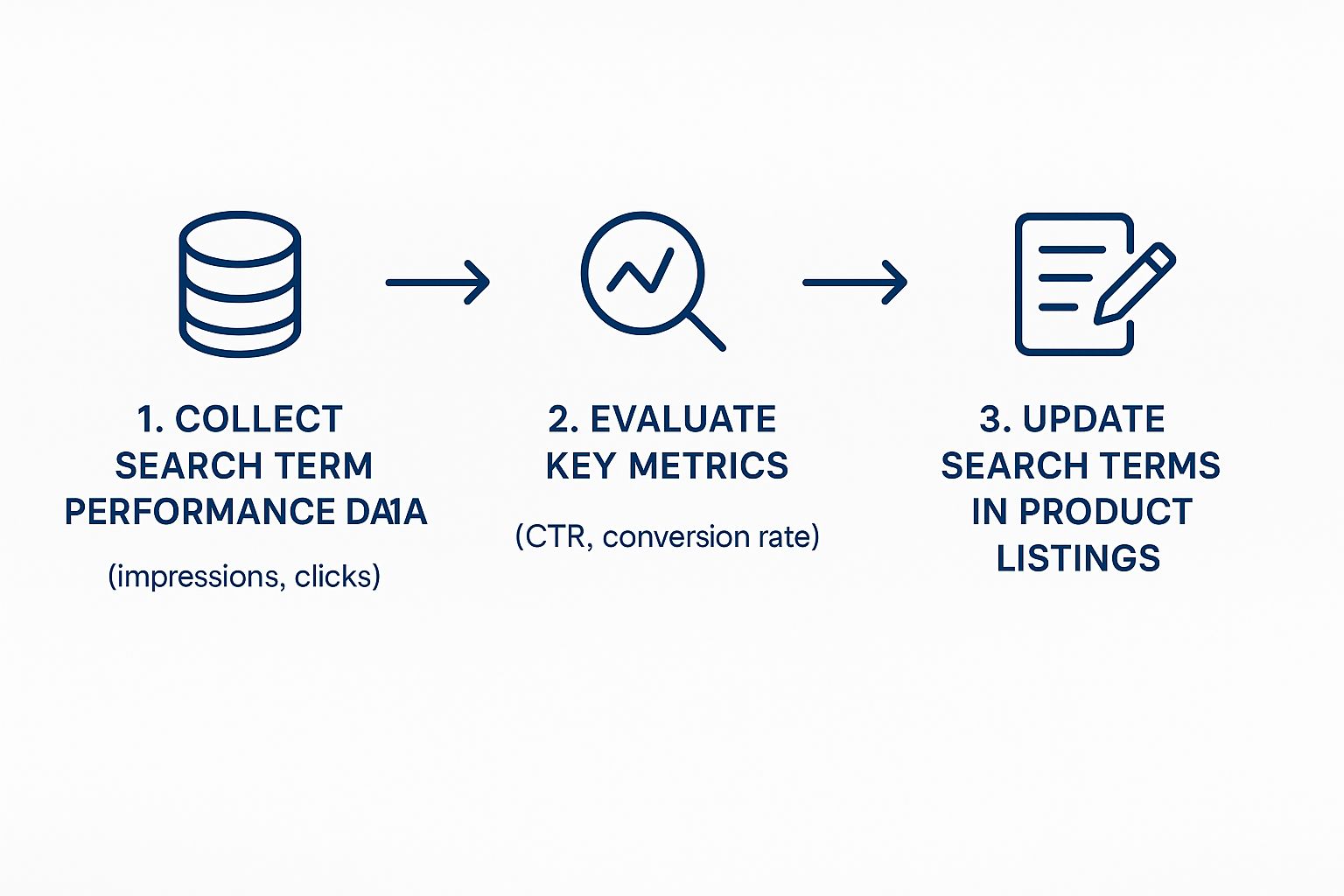Amazon Search Term Optimization: A Performance-First Guide for Brands
Learn Amazon search term optimization to improve rankings, increase sales, and grow sustainably. Start optimizing today for better results!

Let's be clear: optimizing for Amazon search is not traditional SEO. It's a performance marketing discipline where sales are the ultimate ranking factor. Success boils down to two metrics: sales velocity and conversion rates. The A10 algorithm doesn't care about keyword density; it rewards products that prove they can turn clicks into cash. The most sophisticated brands on the platform treat every search term as a strategic investment, measured by its ability to drive profitable growth.
Adopt a Performance-First Mindset for Amazon Search

If you're an eCommerce leader applying your Google playbook to Amazon, you're lighting money on fire. Amazon’s A10 algorithm—the brain behind its search and ranking—is a different beast entirely. It’s not just a search engine; it’s a product discovery engine engineered with a single, laser-focused purpose: to generate sales.
This means while keyword relevance is the ticket to the game, it won’t win you the championship. The A10 algorithm elevates products that demonstrate a high probability of converting a browser into a buyer. Every click that doesn't result in a purchase can signal to the algorithm that your product is a poor match for a query, potentially harming your rank. It's time to shift from a "traffic-first" approach to a "performance-first" mindset.
Conversion Is the Name of the Game
Unlearn everything you know about backlinks and domain authority. Those metrics are irrelevant here. On Amazon, the factors that truly move the needle are all tied directly to sales performance.
Here's what drives rank:
- Sales Velocity: The speed and volume of sales attributed to a specific search term. The more units you move for "waterproof hiking backpack," the higher Amazon ranks you for that query. It’s that direct.
- Conversion Rate (CVR): The percentage of shoppers who buy after landing on your product page. A high CVR sends a powerful signal to Amazon that your product satisfies customer intent for a given search.
- Click-Through Rate (CTR): When your product appears in search, what percentage of shoppers click on it? A strong CTR tells the algorithm that your main image, title, and price are compelling and relevant.
Attempting to rank on Amazon without an obsessive focus on conversion is a strategy destined for failure.
To drive this point home, consider the fundamental differences between ranking on Amazon versus Google. They operate in two different commercial universes.
Amazon Search Ranking Factors vs Traditional SEO
| Ranking Factor | Amazon (A10 Algorithm) | Google (Traditional SEO) |
|---|---|---|
| Primary Goal | Transactional (Drive sales) | Informational (Provide answers) |
| Core Metric | Conversion Rate | Relevance & Authority |
| Sales Impact | Directly influences rank (sales velocity) | Indirect (correlation at best) |
| User Signals | Click-to-sale, add-to-cart, reviews | Dwell time, bounce rate, CTR |
| Off-Page Factors | External traffic driving sales | Backlinks, domain authority |
| Key Content | Title, Bullets, A+, Backend Terms | On-page copy, metadata, schema |
As you can see, Amazon is a closed-loop system where sales performance is the ultimate ranking signal. Google cares about providing the best answer; Amazon cares about making the sale.
Data from a deep dive into over 500 seller accounts confirms this, showing that sales metrics consistently trump all other factors. One major study found that a 10% increase in sales velocity for a keyword can lead to a 1-3 position jump in organic rank. A key driver for this organic ranking is often Pay-Per-Click (PPC) sales, where you are essentially buying sales data to prove your product's relevance to the algorithm. For a more detailed look at these findings, you can check out the analysis of Amazon SEO priorities at MyAmazonGuy.com.
PPC Is Your Primary Growth Lever
Understanding this performance-driven ecosystem makes your PPC strategy the most critical tool in your Amazon toolbox. It's not just an advertising channel; it's your main lever for gathering data, proving conversion, and directly boosting your organic rank.
By running targeted PPC campaigns, you can force-feed the algorithm sales for your most important keywords. This kicks off a powerful flywheel: paid ads drive sales, which improves your organic rank, which leads to more organic sales. More sales mean more profit.
This transforms your ad spend from a simple line-item expense into a strategic investment in your brand's long-term dominance. Every dollar spent on a well-run campaign is a down payment on future organic real estate. It’s how you test keyword viability, get real-world performance data, and systematically build the sales history required to win.
Actionable Takeaway: Stop viewing SEO and PPC as separate functions. Your PPC strategy is your organic growth strategy. Invest in PPC to generate keyword-specific sales velocity and feed the A10 algorithm the performance data it needs to reward you with higher organic rankings.
Build Your High-Conversion Keyword Arsenal

The foundation of a winning Amazon strategy isn't a long list of keywords; it's a curated arsenal of search terms proven to convert. Too many brands chase high-volume "vanity" keywords, only to burn through their ad budget on clicks from browsers, not buyers.
A performance-first approach demands profitability from the start. The goal is to build a keyword portfolio that aligns precisely with high-purchase-intent customer searches. This requires moving beyond generic keyword tools and digging into the data that reveals how real people discover and purchase products like yours.
Reverse Engineer Your Competitors
Your top competitors are a goldmine of keyword intelligence, but simply scraping keywords from their titles is a surface-level tactic. Adopt an analyst's mindset and deconstruct their success. Start by identifying the top 3-5 competitors who consistently dominate the top of search, both organically and in paid placements.
These brands are paying to show you what works. Use a reverse ASIN lookup tool to see which keywords they rank for organically and—more importantly—which terms they are bidding on in PPC.
Look for these signals:
- Long-tail keywords: Specific phrases of three or more words, like "waterproof lightweight hiking backpack for women." They have lower search volume but often dramatically higher conversion rates. These are your profit drivers.
- Keyword overlap: When multiple top competitors target the same keyword, it's a strong signal of a core, high-value term for the niche.
- Branded search terms: Analyze how they pair their brand name with product keywords. This provides a blueprint for your own brand defense and conquesting campaigns.
This analysis provides a data-backed starting point. But remember, competitor data is a rearview mirror—it shows what worked for them. Use it as a roadmap, not the final destination.
Mine Your Own Data for Golden Nuggets
Your most valuable keyword data isn't in a third-party tool; it's in your Amazon account. Your PPC Search Term Report is the single most important document for understanding how real customers find and buy your products. It's the unfiltered voice of the market.
This report is pure gold. It provides the exact search queries people typed into Amazon before clicking your ad and completing a purchase.
When analyzing your Search Term Report, you are hunting for queries that demonstrate:
- A High Click-Through Rate (CTR): A clear signal of relevance between your product and the search query.
- A High Conversion Rate (CVR): The ultimate proof. These are the terms already generating revenue.
- A Low Advertising Cost of Sale (ACOS): These are your most profitable, efficient keywords.
By identifying keywords that hit this trifecta, you uncover your "golden nuggets"—the terms delivering the highest return on investment. These are the keywords to double down on, integrating them into your product title, bullet points, and backend search terms to fuel organic rank.
If you want to go deeper on this, our guide on comprehensive Amazon PPC keyword research breaks down the entire process of turning ad data into organic sales.
Listen to the Voice of the Customer
Finally, step away from the spreadsheets and listen. Your customer reviews and Q&A section are overflowing with the exact language your audience uses.
Read your own reviews, then read your top competitors' reviews. Look for patterns: recurring phrases, problems your product solves, and the specific use cases people describe.
- Did a customer praise your yoga mat as "extra grippy for hot yoga"? There's a keyword: "grippy hot yoga mat."
- Are people constantly asking if your blender is "quiet enough for morning smoothies"? You just found another: "quiet personal blender."
These voice-of-customer keywords are incredibly potent because they reflect real-world user experience. Weaving them into your listing not only improves search relevance but also enhances relatability and persuasion, directly boosting conversion.
Actionable Takeaway: Build a multi-layered keyword strategy. Start with competitor analysis, validate and refine with your own PPC data, and enrich your listings with the authentic language from customer reviews. This creates a resilient and highly relevant keyword foundation.
Master Strategic Keyword Placement for Maximum Impact

You've built a powerful, data-backed keyword arsenal. Now comes the critical step: strategic placement. The real art of optimization is knowing precisely where to place those keywords to maximize their impact on the A10 algorithm and persuade human shoppers.
Gone are the days of keyword stuffing. That clumsy tactic creates a poor customer experience and can harm your visibility. Modern optimization is surgical, placing the right terms in the right fields to both attract the algorithm and convert the click.
The Anatomy of a High-Performing Listing
Think of your product detail page as high-value real estate. Every section has a specific job, and sophisticated sellers are meticulous about how they use that space. They understand that some fields are weighted for discovery, while others are designed to close the sale.
Not all fields carry the same weight. The A10 algorithm pays disproportionate attention to certain areas when ranking products. Mastering placement in these high-impact zones is fundamental to sustainable growth.
Your primary focus should be on these four areas:
- Product Title: Your #1 ranking factor. No debate.
- Backend Search Terms: Your secret weapon for broad, relevant indexing.
- Bullet Points: Where persuasive, benefit-driven copy meets crucial keywords.
- A+ Content: A powerful tool for visual storytelling and supplemental keyword indexing.
Decoding the Highest-Impact Keyword Zones
Let’s break down how to optimize each area. When these elements work in concert, your listing becomes a magnet for both the algorithm and your ideal customer.
Product Title
Your Product Title is the single most powerful element for ranking. It carries more algorithmic weight than any other field. Your most critical, highest-volume keyword must be here, ideally near the front.
However, never sacrifice clarity for density. A title like "Eco-Friendly Yoga Mat - 72-Inch Extra Thick TPE Non-Slip for Hot Yoga" works far better than a jumbled mess like "Yoga Mat Mat Yoga Thick Mat Non Slip Hot Yoga Eco Mat." One helps customers and the algorithm; the other just creates confusion.
Bullet Points
Your Bullet Points are indexed heavily by Amazon and are critical for conversion. This is the perfect place to weave in secondary and long-tail keywords naturally. Frame each bullet around a customer benefit or a solution to a problem. This allows you to seamlessly include terms like "lightweight travel yoga mat" or "sweat-proof and easy to clean" while persuading the shopper that your product is the superior choice.
Expert Takeaway: The best listings sell outcomes, not features. Ask, "What problem does this feature solve?" and write your bullets from that perspective. This approach satisfies both the algorithm’s need for keywords and the buyer’s need for a solution.
Backend Search Terms
The Backend Search Term field is one of the most misunderstood yet powerful tools you have. This is your hidden repository for relevant keywords that don't fit naturally into your title or bullets. Use it for synonyms ("handbag" vs. "tote"), common misspellings, and different phrasings for your product.
Amazon provides a strict 249-byte limit. Every character counts. Do not use commas or repeat words already present in your title or bullets. Strategically fill this space with high-value terms to capture traffic you would otherwise miss. To learn more about mastering this, check out some of the great Amazon keyword strategies on Zonhack.com.
A+ Content
Finally, do not overlook your A+ Content. Once seen purely as a conversion tool, it has evolved. Amazon now indexes the text within your A+ modules, including the alt-text for your images. This provides another valuable opportunity to reinforce core keywords within a visually engaging, brand-centric narrative.
To clarify how these elements work together, use this strategic matrix.
Keyword Placement Impact Matrix
This table breaks down where to place your keywords and why, serving as a quick-reference guide for building or auditing your listings.
| Listing Element | Primary Role | Strategic Best Practice |
|---|---|---|
| Product Title | Ranking & Clicks | Place your top 1-3 keywords here, focusing on the most critical term at the beginning. Prioritize clarity and relevance. |
| Bullet Points | Conversion & Ranking | Weave in secondary and long-tail keywords naturally. Focus on benefits, not just features, to persuade shoppers. |
| Backend Search Terms | Indexing & Discovery | Use all 249 bytes for synonyms, misspellings, and terms not used elsewhere. No repeats, no fluff. |
| A+ Content | Conversion & Branding | Reinforce core keywords in image alt-text and descriptive copy. Tell a visual story that supports your main value proposition. |
Actionable Takeaway: Audit your listings against this matrix. Ensure your highest-value keywords occupy the highest-impact fields (Title, Backend Terms) and that your entire listing works cohesively to both rank and convert.
Use PPC to Validate and Amplify Your Organic Strategy
Too many brands treat Amazon PPC as a siloed ad channel—a necessary cost of doing business. This is a fundamental strategic error. On Amazon, your paid advertising is the single most powerful lever for driving organic rank. It is your real-time keyword laboratory and your primary tool for building sales velocity.
Stop guessing which search terms work and start using real-time, transactional data to fuel your entire Amazon strategy.
Your ad spend is not an expense; it's a strategic investment in an organic growth flywheel. Ads prove which keywords convert, driving crucial initial sales. Those sales build the velocity the A10 algorithm requires, which in turn improves your organic rank. Better organic rank generates more "free" sales, reducing your long-term reliance on paid advertising.
Turning PPC Data into an Organic Weapon
Your Amazon Search Term Report is the ultimate source of truth. It's not a theoretical list from a third-party tool; it’s the raw, unfiltered log of the exact phrases shoppers used just before purchasing your product.
Here’s a practical workflow to weaponize this data:
- Launch targeted test campaigns. Isolate new, unproven keywords in their own dedicated Sponsored Products campaigns to gather clean, undeniable performance data.
- Zero in on performance. After letting the campaigns run, analyze your Search Term Report. You are hunting for customer search terms with a high click-through rate (CTR) and, more critically, a strong conversion rate (CVR).
- Harvest the winners. Once you've identified profitable, high-converting terms, act immediately. Migrate these proven keywords from your ad reports directly into your product listing—especially the title, bullets, and backend search term fields.
This is not a one-time task; it is a continuous cycle of testing, learning, and refining.

The insights from your ad campaigns must not stay siloed. They must feed directly back into your on-page strategy, ensuring your listing is perpetually optimized based on what is driving sales right now.
The Sales Velocity Flywheel
Every time a customer clicks your PPC ad for a specific keyword and makes a purchase, you send a direct, powerful signal to Amazon's A10 algorithm. You are effectively telling it, "For the query 'waterproof running belt,' my product is an excellent match." That sale speaks far louder than simply having the keyword in your listing.
This concept is known as building keyword-specific sales velocity. Amazon doesn't just see a sale; it attributes that sale to the search term that initiated it. By using PPC to strategically generate sales for your most important keywords, you are training the algorithm to rank you for them organically.
Consider launching a new product. It has zero sales history, burying its organic rank on page 20. Instead of waiting for organic discovery, you can launch aggressive PPC campaigns on your top 5-10 target keywords. Those initial ad-driven sales build the purchase history needed to kickstart organic visibility far faster than passive optimization. This is how challenger brands can rapidly climb the ranks and disrupt established leaders. For example, a new electronics brand we worked with achieved page-one ranking for three of their primary keywords within 60 days by using a targeted PPC launch strategy that generated over 200 keyword-specific sales in the first month.
This cycle is the heart of a modern, data-driven Amazon strategy. If you want to get into the nitty-gritty of campaign structure, our guide on advanced Amazon PPC optimization walks through how to build a full-funnel approach that gets this flywheel spinning at scale.
Measuring the True ROI of Your Ad Spend
This integrated approach requires a more sophisticated way of measuring success. Judging PPC on Advertising Cost of Sale (ACoS) alone is dangerously shortsighted.
Enter Total Advertising Cost of Sale (TACoS). This metric measures your ad spend against your total revenue (paid + organic sales), providing a true gauge of marketing efficiency.
A winning strategy often shows a decreasing TACoS over time. Even if your ACoS holds steady, the resulting boost in organic sales means your overall marketing investment is becoming more efficient. Your ad budget is no longer just buying today's sales; it's building a long-term, self-sustaining asset that drives profitable growth.
Actionable Takeaway: Implement a cyclical optimization process. Use PPC to test keywords, harvest high-converting terms from your Search Term Reports, and integrate them into your listing. Measure success with TACoS to understand the true impact of your ad spend on total, profitable growth.
The Amazon Algorithm Is Always Moving the Goalposts—Are You Keeping Up?
The Amazon marketplace is a dynamic ecosystem. What worked last quarter might be obsolete today. Brands that treat optimization as a “set it and forget it” task are the first to be left behind.
Amazon's A10 algorithm is constantly being refined, meaning your approach to search term optimization must be equally dynamic. Success isn't about a secret formula; it's about a resilient, repeatable system that adapts to algorithmic shifts and capitalizes on new opportunities. If you aren't agile enough to pivot when the data demands it, you risk a sudden, painful drop in visibility and sales.
How to React to the Latest Algorithm Changes
Amazon is always tweaking its algorithm to improve the customer experience, and those tweaks directly impact your product rankings. One of the most significant recent shifts is the increased weight given to text within A+ Content. For years, sellers treated A+ as a purely visual space. That is no longer a viable strategy.
We've seen it firsthand: listings that relied solely on image-based A+ Content experienced significant ranking drops for secondary keywords, while those with keyword-rich descriptive text held strong or climbed. Simultaneously, the algorithm is penalizing archaic tactics like keyword stuffing in titles. The message from Amazon is clear: anything that degrades the customer experience is a liability. For a deeper dive into these recent ranking shifts, check out this analysis from ecomclips.com.
The takeaway is clear: keywords matter everywhere. Your A+ Content, including image alt-text, is now a crucial piece of your optimization puzzle.
Why Continuous Monitoring Is Not Optional
In this fluid environment, a passive approach is a recipe for failure. You cannot afford to be caught off guard by a sudden ranking drop. Proactive monitoring of keyword positions and indexing is the only way to protect your visibility and revenue.
Here’s what that looks like in practice:
- Track Your Keyword Ranks: Use a reliable tool to monitor your organic rank for your top 10-20 most important keywords. A core term dropping from position #3 to #12 overnight is a five-alarm fire that requires immediate diagnosis.
- Check Your Indexing: Regularly confirm that Amazon is showing your product for your target keywords. A quick search for your ASIN + keyword (e.g.,
B012345678 "waterproof hiking backpack") will tell you if you're indexed. If not, you're invisible. - Analyze Performance Metrics: Watch your unit session percentage (conversion rate) like a hawk. A dip could signal a new competitor, a pricing issue, or a change in how the algorithm perceives your listing's relevance.
This constant vigilance allows you to spot problems before they become disasters, enabling small, strategic adjustments instead of panicked, reactive overhauls.
The Big Picture: Treat your Amazon strategy as a living document, not a one-time project. The brands that consistently win are those that build a process for continuous monitoring and adaptation. They see algorithm updates not as threats, but as opportunities to outmaneuver slower competitors.
This commitment to continuous improvement is also the cornerstone of a smart advertising strategy. By refining your approach based on real-time data, you create a powerful flywheel between paid and organic efforts. Our guide on holistic Amazon advertising optimization breaks down how this integrated approach drives sustainable growth.
Actionable Takeaway: Establish a weekly and monthly monitoring cadence. Weekly, check your top 5 keyword ranks and PPC performance. Monthly, conduct a deeper audit of indexing, conversion rates, and competitor positioning. Use these insights to make agile adjustments to your listings and ad campaigns.
Your Top Amazon SEO Questions Answered
Even the sharpest eCommerce leaders face complex situations on Amazon. You need direct, no-nonsense answers, not just theory. Here are the most critical questions we get about Amazon search terms, answered with practical, performance-focused advice.
How Often Should I Update My Amazon Search Terms?
Think in two cadences. Avoid constant tinkering with your title and core listing fields, as this can disrupt ranking momentum.
First, schedule a major keyword and listing review every quarter. This is your opportunity to step back, analyze market trends, assess new competitor threats, and implement significant strategic shifts based on accumulated data.
Second, you must analyze your PPC Search Term Reports at least weekly or bi-weekly. This is where you find high-intent, long-tail keywords directly from customer searches. These "golden nuggets" should be immediately added to your backend search terms and new PPC campaigns to capture incremental traffic and sales without disturbing your core listing.
What's More Important: A High-Volume or High-Conversion Keyword?
Without question, a high-conversion keyword is always more valuable. Chasing massive search volume with a low conversion rate is a classic mistake that burns ad budget and signals to the A10 algorithm that your product is a poor match for the query, which can harm your organic rank.
The objective is to find the sweet spot: keywords with relevant search volume that you can prove convert profitably for your product.
Your own PPC data is the only source of truth. It's far better to own the #1 spot for a keyword with 500 monthly searches that converts at 30% than to be on page three for a vanity term with 50,000 searches that converts at 1%. One builds a profitable business; the other is a cash incinerator.
Can I Just Use an AI Tool for All My Keyword Research?
AI tools are excellent for initial research and scale. They can rapidly generate extensive keyword lists and perform competitor analysis, providing a strong starting point and uncovering opportunities you might have missed. However, relying solely on AI is a strategic error.
The optimal strategy is a hybrid approach: AI for breadth, human analysis for depth. You must get your hands dirty. Dig into your own PPC Search Term Reports. Read customer reviews to understand the nuances of their language. Grasp the slang, pain points, and use cases specific to your audience. An AI cannot replicate the intuitive understanding of customer intent and market context that an experienced human analyst brings. Use AI to cast the net, but use your brain and your own data to find the treasure.
My Main Competitor Is Ranking for a Keyword I Can't Seem to Crack. What Should I Do?
A head-on assault against an entrenched competitor on their top keyword is usually a losing, expensive battle. They likely have years of sales velocity for that term, which the A10 algorithm heavily favors.
Instead, execute a flanking maneuver. Use keyword tools to identify long-tail variations of that primary keyword where your competitor is less dominant. Target these more specific, higher-intent phrases aggressively in your exact-match PPC campaigns. This allows you to build your own sales history in a less contested space. As you accumulate sales for these related terms, you prove your product's relevance to the broader topic. This gradually improves your organic rank for the main head term, allowing you to eventually challenge the incumbent from a position of strength, not desperation.
At Headline Marketing Agency, we transform these challenges into scalable growth. We operate at the intersection of data science and performance marketing, using a proven methodology to make your PPC campaigns fuel your organic rankings and long-term profitability. If you're ready to move beyond generic advice and implement a strategy that drives measurable results, let's talk. Discover how we can help you scale.
Ready to Transform Your Amazon PPC Performance?
Get a comprehensive audit of your Amazon PPC campaigns and discover untapped growth opportunities.
